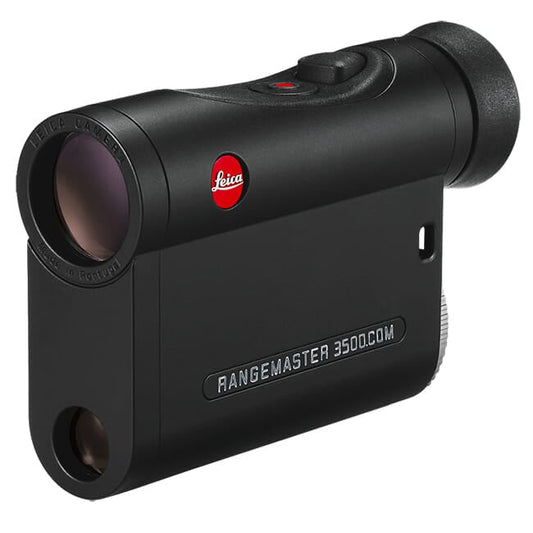

Leica CRF Rangemaster Rangefinder 3500.COM 40508 provides precise distance measurement up to 3,500 yards, making it ideal for serious shooters and outdoor enthusiasts. This rangefinder features Bluetooth connectivity that allows integration with the Leica Hunting App, enabling customizable ballistic settings tailored to specific needs. Designed for both archery and rifle shooting, it delivers quick readings in about 0.3 seconds, so you can focus on your target without delay.
Constructed with a carbon fiber-reinforced body, this rangefinder is built to withstand harsh outdoor conditions, ensuring durability and reliability. The high-contrast LED display automatically adjusts to varying light conditions, facilitating clear visibility in any environment. Whether you're calculating holdover, angle, or atmospheric pressure, the Rangemaster 3500.COM offers comprehensive ballistic outputs, making it an essential tool for precision shooting.
Key Features:
- ADVANCED BALLISTICS: Integrated Bluetooth pairs with the Leica Hunting App for personalized ballistic data.
- IMMENSE RANGE: Measures distances up to 3,500 yards with unmatched accuracy.
- RAPID MEASUREMENTS: Delivers fast results in approximately 0.3 seconds, ideal for quick target acquisition.
- BUILT TO LAST: Durable carbon fiber-reinforced housing is watertight up to 3.2 ft.
- HIGH VISIBILITY DISPLAY: LED display with auto-adjustment to ambient lighting for optimal readability.
- KESTREL COMPATIBILITY: Syncs with Kestrel weather meters for real-time environmental data.
- PRECISION FOR ARCHERS: Accurate to 0.1 yards for close-range targeting, perfect for archery.
- USER-FRIENDLY INTERFACE: Offers scan mode, single measurements, and a lengthy battery life of 1,700 measurements.
Technical Specifications
| Specification | Detail |
|---|---|
| Weight | 6.7 oz. |
| Dimensions | 4.5 x 2.25 x 1.25 in |
| Field of View | 115m @ 1000m |
| Exit Pupil | 3.4mm |
| Range | 10 yds - 3,500 yds |
| Objective Lens Diameter | 24mm |
| Laser | Class 3R |
| Measurement Units | Yards/inches or meter/centimeter |
| Battery Type | 3V Lithium Type CR2 |
| Monocular Details | 7x Magnification; 24mm Objective |
| Measuring Time | Approx. 0.3 seconds |
| Magnification Range | 7x |
| Item Condition | New |
| UPC | 4022243405080 |
| MPN | 40508 |
| Product Type | Laser Range Finder |
What's in the Box?
- Leica CRF Rangemaster Rangefinder 3500.COM 40508
- Carrying Case
- Battery
- Cordura Holster
- Cleaning Cloth
- User Manual
Customer Reviews
"This rangefinder is incredibly accurate and easy to use. The Bluetooth feature is a game-changer for my shooting practice." - Alex T.
"I've used several rangefinders, but the Leica 3500.COM stands out for its fast readouts and durability." - Jamie L.
FAQ
How accurate is the Leica CRF Rangemaster 3500.COM? This rangefinder provides highly accurate measurements, capable of measuring down to 0.1 yards. It's designed for precision shooting, whether for hunting or competitive use.
What maintenance does the rangefinder require? Regular cleaning of the lens with a soft cloth is recommended, along with ensuring the battery is charged. The device is built to withstand extreme conditions, but keeping it dry and dirt-free extends its lifespan.
How does this compare to other rangefinders? Compared to other models, the Leica CRF Rangemaster offers superior range and accuracy. Its integration with the Leica Hunting App allows for personalized ballistic adjustments, which many competitors do not feature.
Similar Models
Explore additional options from Leica to find the perfect rangefinder for your needs. Check out the Leica CRF 2000-B for compact performance or the Leica Rangemaster 1600.R for an alternative with slightly different features. Discover the full collection for more high-quality optics tailored to your adventures.You May Also Like
Here’s some of our most similar products people are buying. Click to discover trending style.










